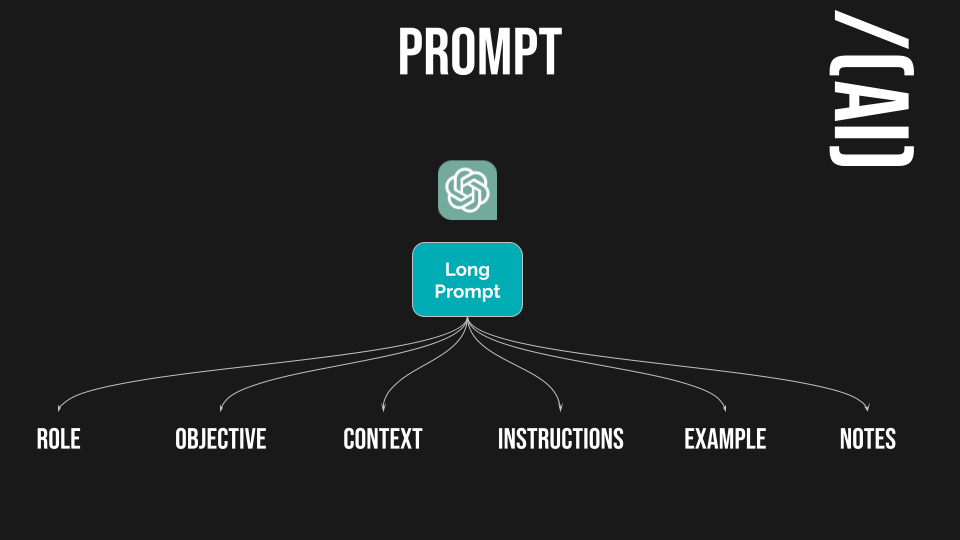Are all Prompts a like
There are different types of prompts that can be used and each one depends on what you are trying to achieve.


How to Write Effective AI Prompts: Short, Long, and Agent Prompts
As AI continues to revolutionize industries, mastering the art of prompt writing is essential to getting the best results. Whether you're using AI for content creation, automation, or complex decision-making, how you structure your prompt determines the quality of the AI’s response.
In this blog, we’ll break down three key types of prompts; Short, Long, and Agent Prompts explaining their differences and how to use each effectively.
1. Short Prompts
Short prompts are simplified, efficient, and perfect for quick AI interactions.
Use Cases for Short Prompts:
Extracting specific details (pulling names from a document).
Generating quick summaries without unnecessary details.
Formatting short texts according to predefined rules.
Structure of a Short Prompt:
Objective: State the task clearly in one sentence.
Example: "Identify the full name from the CV below."
Instructions: Provide clear output rules to avoid unnecessary information.
Example: "Only output the full name—no summary, no explanation, nothing but the full name."
Variable: Include the relevant data directly below the instructions.
Example: "CV Content: CV.pdf"
Example (Optional): If needed, add an expected output example.
Example: "If no name is found, output 'No name found' "
2. Long Prompts
A Long Prompt is ideal for complex tasks that require precise formatting, step-by-step execution, or specific constraints.
Use Cases for Long Prompts:
Formatting detailed reports or documents.
Providing structured output for legal or technical documentation.
Generating AI-assisted responses that require multiple steps.
Structure of a Long Prompt:
Role (Persona): Define the AI’s role to establish its expertise.
Example: "You are a world-class CV formatter with expertise in reformatting CVs meticulously."
Objective (Task): Clearly state what the AI needs to do.
Example: "Your goal is to carefully reformat the CV following a step-by-step process."
Context: Provide background on why the task is important.
Example: "This task is crucial to our recruitment firm, as the reformatted CV will be presented to potential clients."
Instructions: Detail specific rules and guidelines for completing the task.
Example: "Do not modify or remove any information from the original CV."
Variables: Include the necessary data or content for the AI to process.
Example: "Here is the original CV content: [Insert CV text here]"
Examples: Provide input-output examples to guide AI responses.
Example: "Original CV: [Sample text] → Reformatted CV: [Expected output]"
Notes: Reiterate key rules and preferences for better accuracy.
3. Agent Prompts
Agent prompts are designed for AI-driven systems that handle multiple tasks, delegate actions, and interact with sub-agents or tools.
Use Cases for Agent Prompts:
Managing multi-step workflows (e.g., scheduling, emailing, and data entry).
Acting as a virtual assistant with delegated tasks.
Handling decision-making processes with clear step-by-step logic.
Structure of an Agent Prompt:
Role (Persona): Assign the AI a role with multiple responsibilities.
Example: "You are an AI personal assistant managing emails, scheduling, and database entries."
Objective (Task): Define what the AI is expected to accomplish.
Example: "Your goal is to manage tasks using specialized sub-agents, following a step-by-step approach for accuracy."
Context: Explain why the task is important for workflow automation.
Example: "Ensuring timely responses and tracking commitments improves team efficiency."
Standard Operating Procedure (SOP): Break the workflow into clear steps.
Example: "If an email needs a response, use 'Email Manager' to draft and send."
Instructions/Rules: Define how AI should interact with tools or sub-agents.
Example: "Always confirm meeting times with the 'Calendar Manager' before scheduling."
Tools and Sub-Agents: List available tools and their functions.
Example: "Calendar Manager: Schedules and retrieves meeting times."
Examples: Provide input-output samples to show how tasks should be handled.
Example: "Request: 'Schedule a meeting' → Response: 'Meeting set for Monday at 10 AM.'"
Notes: Reinforce key rules, such as handling errors or following escalation procedures.
Key Differences
Short Prompt: Low Quick tasks, simple commands, and fast interactions Efficiency and speed
Long Prompt: High Structured responses, detailed formatting, and strict guidelines Precision and depth
Agent Prompt: Very High AI-driven workflows, multi-step automation, and task delegation Scalability and automation
Final Thoughts
Mastering prompt writing is essential for maximizing AI effectiveness. Whether you need structured precision, quick responses, or AI-driven automation, choosing the right prompt structure ensures the best possible results.
At PIA Solutions, we specialize in AI integration, automation, and process optimization to help businesses leverage AI effectively. If you're looking to improve workflow efficiency and AI adoption, let’s work together to build tailored solutions for your business.
